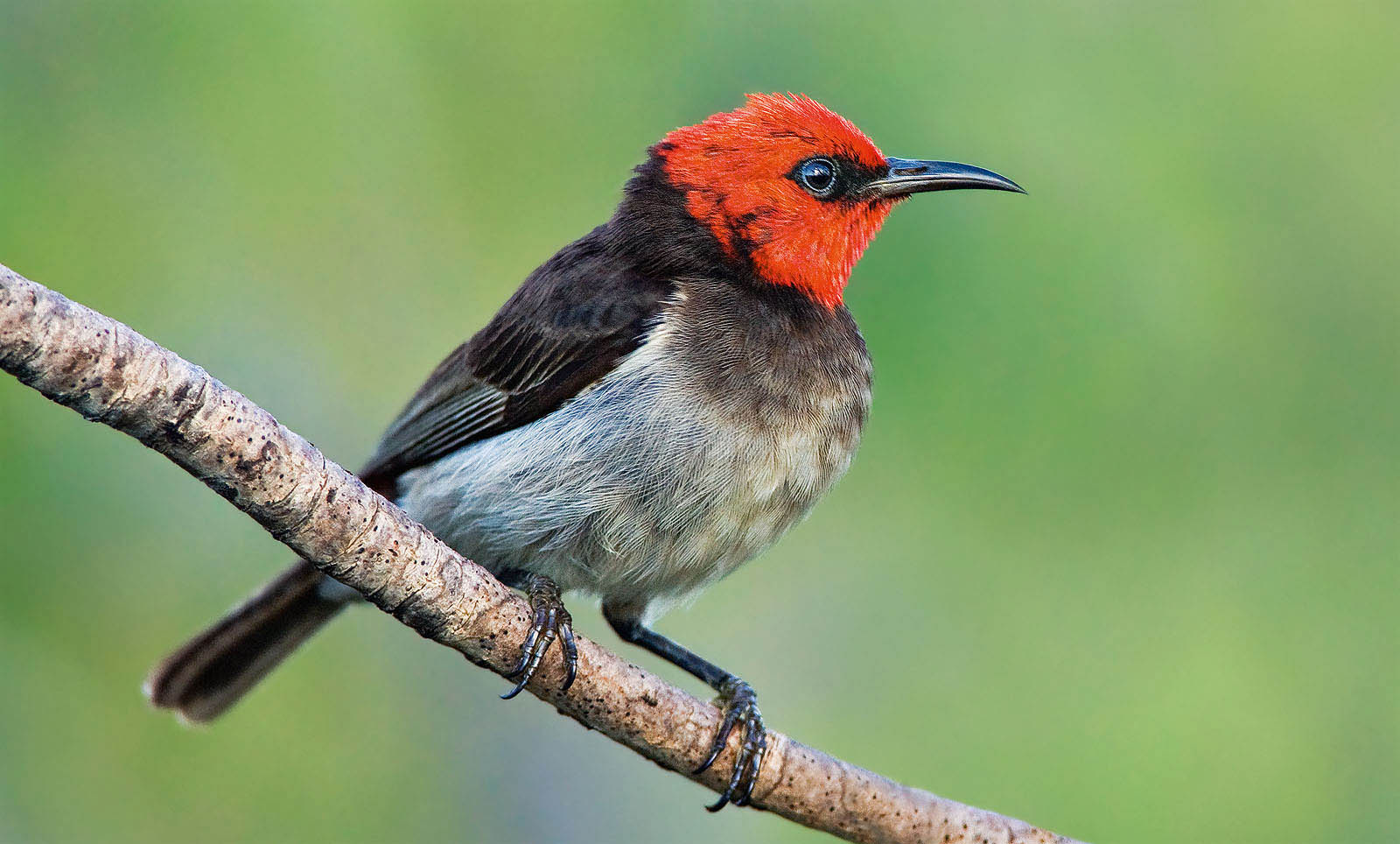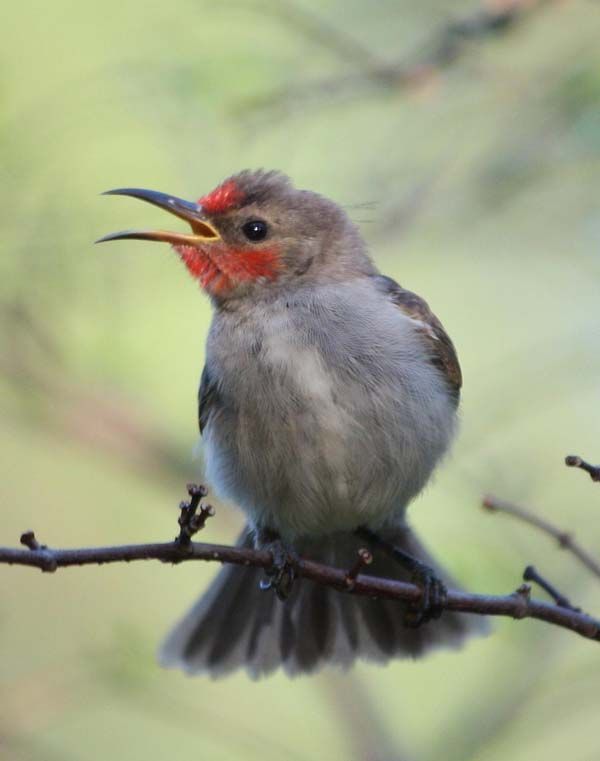
Redheaded Honeyeater (Myzomela erythrocephala)
18 Red-headed Honeyeater (Myzomela erythrocephala) Alternate name (s): "Mangrove Red-head", "Bloodbird * ", "Myzomela * " Size: 11-13 cm; wing span 17-19 cm Weight: 6-11 g Similar species Description Classification Distribution Sightings Photos Breeding Nest Eggs Behaviour Food Call/s Photos Race "erythrocephala" ADULT MALE

Redheaded Honeyeater (Myzomela erythrocephala)
9cm Maximum Size: 11cm Average size: 10cm Average weight: 8g Breeding season: July to January Clutch Size: Usually 2 Incubation: 12 days Nestling Period: 12 days Conservation Status Federal: Secure NSW: Secure

Redheaded Honeyeater (Myzomela erythrocephala)
Red-headed Honeyeater Myzomela erythrocephala Species No.: 587 Band size: 01 AY Morphometrics: Adult Male Adult Female THL: 28.0 - 41.1 mm 27.3 - 39.4 mm. Rump & red; brown with lighter brown or light light brown; uppertail grey-brown fringes and some coverts: have a few fringed red; Juveniles undergo a partial moult to a non-breeding.

Redheaded Honeyeater David Bettini
The Red-headed Honeyeater (12 cm) lives in mangroves, swamps and forests of the tropical north. One of three Australian members of the Myzomela family, all small and acrobatic birds. The Blue-faced Honeyeater (31 cm) ranges from the north and east to South Australia. In open woodlands to river edges and mangroves.

Redheaded Honeyeater (Myzomela erythrocephala)
The red-headed myzomela or red-headed honeyeater is a passerine bird of the honeyeater family Meliphagidae found in Australia, Indonesia, and Papua New Guinea. It was described by John Gould in 1840. Two subspecies are recognised, with the nominate race M. e. erythrocephala distributed around the tropical coastline of Australia, and M. e. infuscata in New Guinea.

Redheaded Honeyeater (Myzomela erythrocephala)
Meliphagidae (honeyeaters and chats) Scientific name Myzomela erythrocephala (Gould, 1840) Common name red-headed honeyeater WildNet taxon ID 1487 Alternate name(s) red-headed myzomela Nature Conservation Act 1992 (NCA) status Least concern Conservation significant No Endemicity Native Pest status Nil Species environment Terrestrial Other resources

Redheaded myzomela Wikipedia
(Viewing 4 of 8 photos) Red-headed Honeyeaters inhabit mangroves, not exclusively, but preferably. In Australia they are restricted to the northern coastline, south to near Broome in W.A. and to Princess Charlotte Bay in Qld. They occur also in southern New Guinea and other outlying islands as far as Sumba.

Redheaded Honeyeater (Myzomela erythrocephala)
The earliest known use of the noun red-headed honeyeater is in the 1840s. OED's earliest evidence for red-headed honeyeater is from 1848, in the writing of John Gould, ornithologist and publisher. red-headed honeyeater is formed within English, by compounding.

Redheaded Honeyeater (Myzomela erythrocephala)
The red-headed myzomela or red-headed honeyeater (Myzomela erythrocephala) is a passerine bird of the honeyeater family, Meliphagidae, found in Australia, Indonesia, and Papua New Guinea. It was described by John Gould in 1840. Two subspecies are recognised, with the nominate race M. e. erythrocephala distributed around the tropical coastline of Australia, and M. e. infuscata in New Guinea.

Redheaded Honeyeater (Myzomela erythrocephala)
Honeyeaters are a diverse group of Australian birds belonging to the family Meliphagidae. One of their special characteristics is a 'brush-tipped' tongue, with which they take up nectar from flowers. However, nectar is only one of their foods. Most honeyeaters also eat insects, and some eat more insects than nectar.

Redheaded Honeyeater (Myzomela erythrocephala)
The red-headed myzomela or red-headed honeyeater ( Myzomela erythrocephala ) is a passerine bird of the honeyeater family Meliphagidae found in Australia, Indonesia, and Papua New Guinea. It was described by John Gould in 1840.

Redheaded Honeyeater (Myzomela erythrocephala)
They are a large and diverse family of small to medium-sized birds most common in Australia and New Guinea, but also found in New Zealand, the Pacific islands as far east as Samoa and Tonga, and the islands to the north and west of New Guinea known as Wallacea . Family: Meliphagidae Yellow wattlebird ( Anthochaera paradoxa) Sugomel

Redheaded Honeyeater (Myzomela erythrocephala)
Tiny honeyeater with a short tail. Adult males have striking bright red face and rump, black wings and back, and gray underparts. Adult females have small amounts of faint red on the face but lack the red rump. Juveniles are similar to adult females but have less red on the face. Typically found in coastal habitats: almost exclusively in mangroves and adjacent forest.

Redheaded Honeyeater BIRDS in BACKYARDS
The Red-headed Honeyeater is classified as Least Concern. Does not qualify for a more at risk category. Widespread and abundant taxa are included in this category. The Red-headed Honeyeater (Myzomela erythrocephala) is a species of bird in the Meliphagidae family, found in Australia, Indonesia, and Papua New Guinea.

Redheaded Honeyeater BIRDS in BACKYARDS
Red-headed Honeyeater. Distribution States. Northern Territory, Queensland, Western Australia . Note that conversion of the original AFD map of states, drainage basins and coastal and oceanic zones to IBRA and IMCRA regions may have produced errors. The new maps will be reviewed and corrected as updates occur..

Redheaded Honeyeater (Myzomela erythrocephala)
The red-headed myzomela or red-headed honeyeater is a passerine bird of the honeyeater family, Meliphagidae, found in Australia, Indonesia, and Papua New Guinea. Three subspecies are recognised, with the nominate race ''M. erythrocephala erythrocephala'' distributed around the tropical coastline of Australia. At 12 centimetres , it is a small honeyeater with a short tail and relatively long.